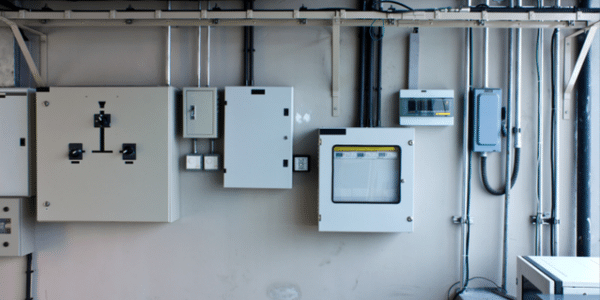Exploring the Role of Electrical Fiberglass Boxes in Healthcare Facility Design
6/27/20244 min read


Introduction to Electrical Fiberglass Boxes in Healthcare
Electrical fiberglass boxes are crucial components in the design and functionality of healthcare facilities. These boxes serve as enclosures for electrical connections, housing various electrical equipment and ensuring the safety and efficiency of electrical systems within the facility. Typically constructed from fiberglass-reinforced plastic, these boxes offer several advantages over traditional materials like metal or plastic, making them particularly suited for healthcare environments.
The primary function of electrical fiberglass boxes is to protect electrical connections and equipment from environmental factors such as moisture, dust, and physical impact. This is especially important in healthcare settings, where reliable and uninterrupted power supply is critical for patient safety and the operation of medical devices. Fiberglass boxes are designed to meet stringent electrical safety standards, including those set by organizations such as the National Electrical Manufacturers Association (NEMA) and Underwriters Laboratories (UL), ensuring that they provide adequate protection and performance.
Healthcare facilities have specific requirements for electrical safety, driven by the need to minimize risks such as electrical shock, fire hazards, and equipment failure. Electrical fiberglass boxes help meet these standards by offering a range of benefits. Firstly, they are highly durable and resistant to corrosion, which prolongs their lifespan and ensures consistent performance over time. Unlike metal boxes, fiberglass boxes do not rust, making them ideal for environments where moisture and cleaning agents are frequently present.
Another significant advantage of fiberglass boxes is their non-conductive nature. This property reduces the risk of electrical shock, which is a critical consideration in healthcare settings where patients and staff are in close proximity to electrical equipment. Additionally, fiberglass boxes are lightweight, making them easier to install and maintain compared to their metal counterparts.
In summary, electrical fiberglass boxes play a vital role in healthcare facility design by providing robust protection for electrical systems, meeting stringent safety standards, and offering practical benefits such as durability, corrosion resistance, and non-conductivity. Their use ensures the reliability and safety of electrical infrastructure, ultimately contributing to the overall safety and efficiency of healthcare environments.
Advantages of Using Fiberglass Boxes in Healthcare Settings
In healthcare environments, the selection of electrical enclosures is paramount to ensuring safety and efficiency. Electrical fiberglass boxes stand out as an optimal choice due to their myriad advantages. One of the foremost benefits is their non-conductive nature, which significantly reduces the risk of electrical hazards. This feature is particularly critical in healthcare settings, where the safety of patients and staff must be meticulously guarded.
Additionally, fiberglass boxes are highly resistant to moisture, chemicals, and other environmental factors. In a healthcare facility, where exposure to various cleaning agents and occasional spills is inevitable, this resistance ensures that the electrical systems remain unaffected and operational. The durability of fiberglass also means that it can withstand the demanding conditions frequently encountered in medical environments without corroding or degrading over time.
Ease of installation and maintenance further enhances the appeal of fiberglass boxes in healthcare settings. The lightweight nature of fiberglass makes the installation process less cumbersome, which is a significant advantage in fast-paced healthcare facilities where time and efficiency are crucial. Moreover, the maintenance of fiberglass boxes is straightforward, requiring minimal effort to keep them in excellent condition. This ease of maintenance ensures that healthcare facilities can allocate their resources more effectively, focusing on patient care rather than frequent repairs or replacements of electrical enclosures.
From a cost-effectiveness perspective, the long-term benefits of fiberglass boxes are noteworthy. Their longevity and durability mean that they do not need to be replaced as frequently as enclosures made from other materials. This results in reduced long-term costs and fewer disruptions to the facility's operations. Additionally, the lower maintenance requirements translate to further savings, making fiberglass boxes a financially prudent choice for healthcare facilities looking to optimize their expenditures while maintaining high safety and reliability standards.
Case Studies and Best Practices in Healthcare Facility Design
Healthcare facilities must adhere to rigorous standards, especially concerning their electrical systems. One exemplary case is the renovation of the Westside Medical Center. The project faced the challenge of modernizing an aging electrical infrastructure without disrupting daily operations. Integrating electrical fiberglass boxes proved to be a game-changer. These boxes were chosen for their non-conductive properties, ensuring enhanced safety in environments with high moisture levels. The lightweight nature of fiberglass facilitated easier installation, minimizing downtime and operational disruptions.
Another notable example is the Greenfield Pediatric Hospital, which required extensive electrical upgrades to support advanced medical equipment. Here, the use of electrical fiberglass boxes mitigated the risk of corrosion, a common issue with traditional metal enclosures in humid climates. By opting for fiberglass, the facility extended the lifespan of their electrical systems and reduced long-term maintenance costs. This choice also aligned with their sustainability goals, as fiberglass is a more environmentally friendly option due to its durability and reduced need for replacements.
When selecting electrical fiberglass boxes for healthcare settings, it is crucial to consider factors such as size, load capacity, and environmental conditions. Best practices suggest conducting a thorough needs assessment to match the box specifications with the facility's requirements. During installation, ensuring that the boxes are securely mounted and properly sealed is essential to maintain their protective qualities. Routine maintenance should include periodic inspections for any signs of wear or damage, ensuring that the boxes continue to perform optimally.
Looking ahead, advancements in materials and technology indicate a promising future for fiberglass boxes in healthcare. Innovations such as enhanced fire resistance and improved thermal properties are on the horizon, potentially offering even greater safety and efficiency. As healthcare facilities continue to evolve, the integration of electrical fiberglass boxes will likely play a pivotal role in maintaining robust and reliable electrical systems, ultimately contributing to safer and more efficient patient care environments.
